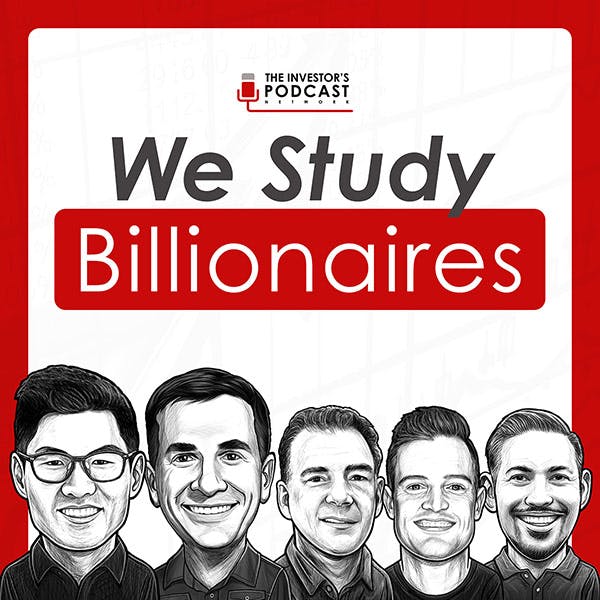
August 7, 2024 • 1hr 1min
BTC194: Tether's Backing and Pear w/ Paolo Ardoino and Mathias Buus (Bitcoin Podcast)
We Study Billionaires - The Investor’s Podcast Network

Key Takeaways
- Tether's financial position is extremely strong, with $1.3 billion in net operating profit, $5.33 billion in excess reserves, and $97.5 billion in US Treasuries as of June 30, 2024.
- Tether has a higher exposure to US Treasuries than countries like Germany, UAE, and Australia. They hold mostly short-term Treasuries (less than 90 days) for liquidity.
- Tether is investing profits into Bitcoin, currently holding around 80,000 BTC. They see Bitcoin as a hedge against inflation and geopolitical risks.
- Tether is developing peer-to-peer technology called Holepunch that allows for decentralized communication and apps without servers, potentially disrupting centralized services.
- The Keet video conferencing app built on Holepunch technology demonstrates high quality video/audio without centralized servers, outperforming services like Zoom.
- Tether may be looking to issue USDT on their own protocol built with Holepunch technology in the future, moving away from other blockchains.
- Tether sees their stablecoin as "agnostic" to blockchains, viewing them simply as transport layers for USDT.
- The Pears initiative aims to create an app store for decentralized applications built on Holepunch technology.
Introduction
In this episode, Preston Pysh interviews Paolo Ardoino, CTO of Tether, and Mathias Buus, lead developer of the Holepunch project. They discuss Tether's strong financial position, their Bitcoin holdings, and new peer-to-peer technology initiatives that could disrupt centralized internet services.
The conversation covers Tether's attestation results, their Treasury holdings, views on Bitcoin as a reserve asset, and development of decentralized communication technology that could change how internet applications function.
Topics Discussed
Tether's Financial Position (3:07)
- As of June 30, 2024, Tether had:
- $1.3 billion in net operating profit
- $5.33 billion in excess reserves
- $97.5 billion in US Treasuries (up $7 billion from previous quarter)
- Tether has a higher exposure to US Treasuries than Germany, UAE, and Australia
- They hold 80,000 Bitcoin with retained earnings
Paolo Ardoino explains that Tether has become very profitable in the last two years due to rising interest rates. They are keeping significant profits as excess reserves rather than distributing them, to demonstrate financial strength.
Tether's Treasury Holdings and Strategy (4:46)
- Tether holds mostly short-term US Treasuries (less than 90 days maturity)
- They also hold some gold as a hedge
- Focus is on liquidity to be able to handle large redemptions quickly
- Conservative approach after surviving $7 billion in redemptions in 48 hours in 2022
"We engineered a very strong machine where we have all the reserves to back USDT. Plus we have $11.89 billion more that we keep in the company to protect our ecosystem." - Paolo Ardoino
Tether's Bitcoin Holdings (8:47)
- Tether owns around 80,000 Bitcoin
- Up to 15% of profits have been put into purchasing Bitcoin
- See Bitcoin as a hedge against inflation and geopolitical risks
Paolo explains they are being conservative with Bitcoin allocation but see it as an important reserve asset to protect against future uncertainty.
Tether's Role in Emerging Markets (8:47)
- USDT provides access to US dollar stability for people in countries with high inflation
- Seeing increased usage in trade finance and as savings vehicle in developing countries
- Goal is to eventually educate users about Bitcoin, but USDT meets immediate needs
"5 billion people live in countries that have very high inflation rate and very fast devaluation of their national currencies. And so the common denominator of all these communities is trying to find a better solution." - Paolo Ardoino
The Pear Initiative and Holepunch Technology (23:17)
- Pear initiative aims to create zero-cost, peer-to-peer infrastructure for apps
- Holepunch technology allows for decentralized communication without servers
- Could disrupt centralized services like Telegram that have high server costs
Mathias Buus explains the goal is to utilize existing computing power and internet connectivity to build powerful apps that run for free without centralized infrastructure.
The Keet Video Conferencing App (26:43)
- Built on Holepunch technology as a showcase application
- Provides high quality video/audio without centralized servers
- Outperforms services like Zoom in video/audio quality
Preston notes the video quality on Keet was better than their Zoom call, which Mathias attributes to not having bandwidth limitations imposed by a centralized service trying to manage costs.
Peer-to-Peer Networking and Security (29:15)
- Holepunch uses point-to-point connectivity similar to original internet design
- Eliminates need for data centers as intermediaries
- Provides inherent security and privacy as data stays on user devices
"Internet was built on a point-to-point connectivity right. Every computer when you connect to Internet has an IP address. It's like your home address." - Paolo Ardoino
Open Source Aspects of Holepunch (37:30)
- Core Holepunch technology is open source across 500+ repositories
- UI layer of Keet app is currently closed source
- Decision to keep UI closed to maintain control of development direction
Mathias explains the core peer-to-peer engine is fully open source, but they've kept the UI layer closed for now to guide development of the flagship Keet app.
Potential for Tether to Use Holepunch Technology (34:25)
- Tether may look to issue USDT on their own protocol built with Holepunch in the future
- See blockchains as simply transport layers for USDT currently
- Believe many blockchain complexities are unnecessary for a centralized stablecoin
"We thought and we discussed and we have already a project plan with Mathias also to build a protocol and payment protocol based on the same technology that powers Keet and Holepunch." - Paolo Ardoino
The Pears App Store Initiative (31:06)
- Developing an app store for decentralized applications built on Holepunch
- Exploring potential for hardware devices optimized for peer-to-peer apps
- See opportunity in low-power devices leveraging peer-to-peer efficiency
Mathias discusses their interest in potentially developing hardware optimized for peer-to-peer applications to overcome limitations of current mobile platforms.
Conclusion
This wide-ranging discussion highlighted Tether's strong financial position and conservative approach to reserves, while also revealing ambitious plans to develop decentralized communication technology. The Holepunch project and Keet app demonstrate the potential for high-quality, serverless applications that could disrupt centralized internet services.
Tether's large Bitcoin holdings and interest in potentially issuing USDT on their own Holepunch-based protocol in the future suggest they see significant long-term potential in decentralized technologies. Their initiatives around peer-to-peer infrastructure and decentralized app stores indicate a vision for reshaping how internet applications function.
Overall, the conversation revealed Tether's evolution from simply a stablecoin issuer to a company actively working to advance decentralized technologies that could have far-reaching impacts on internet communication and finance.









